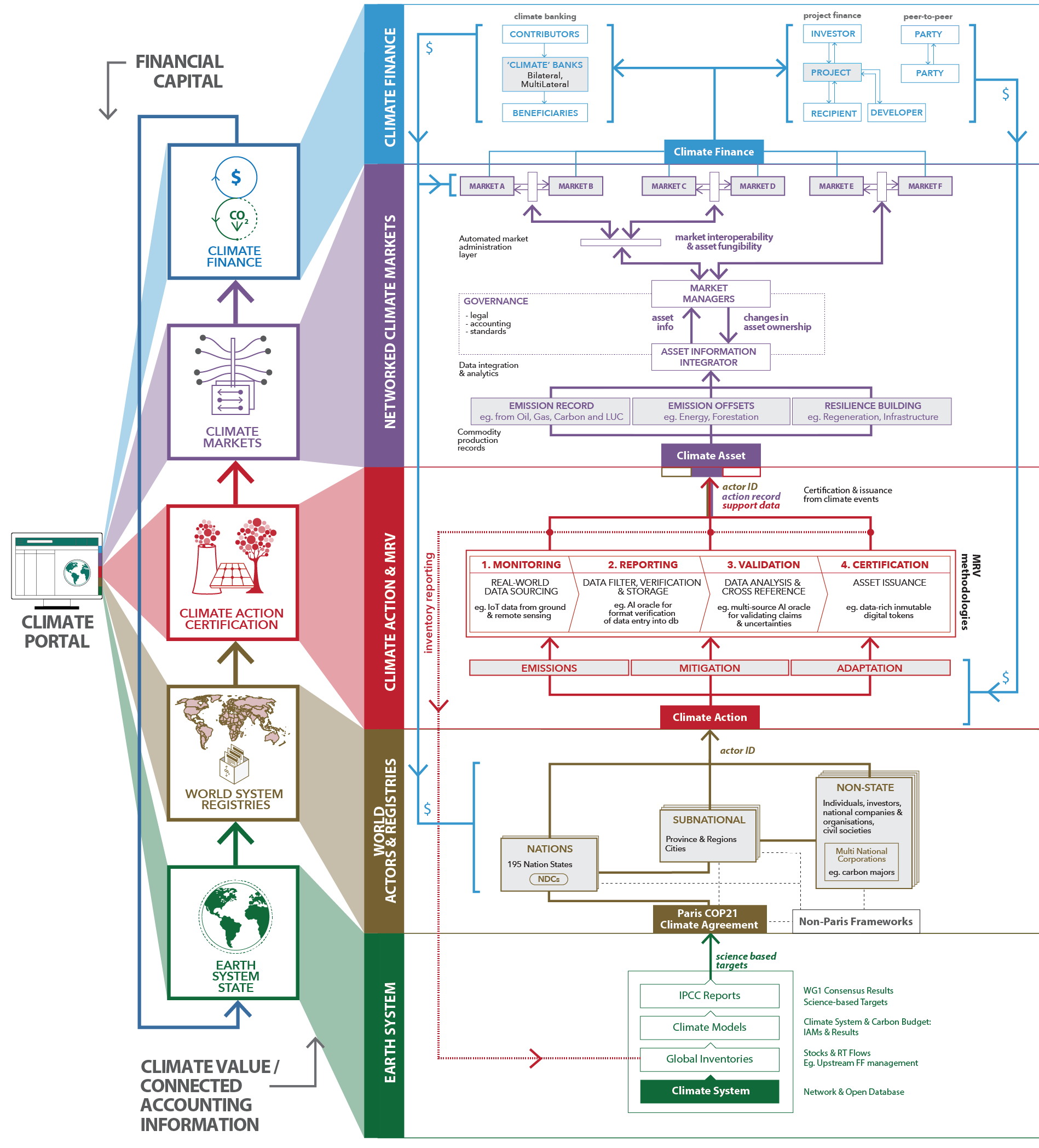
Exploring the use of blockchain for global climate accounting
The open climate project is an open source initiative exploring the application of blockchain and other emerging technologies, such as IoT (Internet of Things), big data and machine learning, to the challenge of helping the world keep a transparent accounting system as we strive to achieve the climate targets set in the 2015 Paris Agreement (PA)—i.e. maintaining anthropogenic warming below 1.5oC. The project is currently incubated at the Yale Open Innovation Lab (openlab) and combines multiple other project components incubated and developed by a growing network of collaborators.
The scope of the project’s vision includes recordswith scientific consensus of Earth’s ecosystem state as it pertains to carbon budget tracking, climate actor pledges, climate action records and certifications, the transaction of these credits/ certificates under international climate markets, and the mobilization of financial capital towards climate action. Such a broad integrated system pertains to a core value proposition that blockchain technology provides. Hosting multiple climate accounting mechanisms connected through shared protocols, allows contractual automation in the link between finance and climate value flow based on agreed physical parameter of the Earth system (eg. 1.5oC warming). As a basis, this can act as a self-enforcing mechanism for the Paris Agreement, as well as enable new Paris-consistent smart contracts with reward & penalty functionalities to ensure accountability.
While the Paris Agreement pertains directly to countries’ roles and responsibilities (i.e. the parties to the UNFCCC), it is now well understood that the most relevant climate action champions are in fact subnational actors, such as cities, and non- state actors such as private corporations and organizations. Furthermore, article 6 of the Paris Agreements introduces the incorporation of bottom- up climate action efforts to parties’ accounts, and the cooperation between parties to achieve their respective nationally determined contributions (NDC) using international transfer of mitigation outcomes (ITMOs). The open climate project specifically targets its development to cater for this bottom-up climate action ecosystem, focusing on the mechanisms by which subnational and non-state actor pledges and certified actions can be incorporated into national efforts and international networked climate markets. In fact, a collaboration with the Data Driven EnviroPolicy Lab lead to the direct support of the National Science Foundation to develop a framework for using blockchain for climate action tracking (b-cat) of non-state actors.
Multi-Layer Integration of Climate Related Ledgers: a metadiagram
This stylized flow diagram provides a visual reference for the potential of applying and integrating blockchain’s record keeping system across multiple layers pertaining to global climate accounting and the enforcement of the 2015 UNFCCC Paris Agreement. An integrated system, involving multiple blockchain mechanisms connected through shared protocols, allows contractual automation in the link between finance and climate value flow based on the agreed physical parameter of the Earth system (eg. 1.5oC). The climate portal allows users to interface with the global accounting system, as well as digital streamlining the interactive processes for individual actors/agents. The diagram also represents a visual summary of the scope of the project’s vision.
*Networked climate market layer adapated from figure 3, World Bank Group “Blockchain and Emerging Digital Technologies for Enhancing Post-2020 Climate Markets,” 2018.
Technology & Platform Development
The project’s main software development efforts entail three main components. First, a decentralized server hosting a cross-platform web application that can integrate multiple existing climate related platforms so that they can interoperate with common functions and reconciled records —thus acting as a climate ‘platform of platforms.’ Second, the consolidation of protocols and standards to enable such an interoperable and multi- layers climate accounting ecosystem, and the required governance mechanism to achieve and maintain it. And third, a climate portal that allows multi-stakeholder users to interface and interacts with the global accounting system, either directly via the web application or via their integrated platforms (see the below figure for a layered software stack with these three outlined components in green).
Project stack & three core development components
This stylized software stack diagram provides a visual reference for how the project is currently prototyped. The main development efforts are contoured in green since the external data sources is comprised by existing climate accounting platforms and the blockchain layer includes emerging blockchain-based applications. Prototype developments in the blockchain layer include common smart contracts (eg. the Paris agreement) and handlers to a diverse set of ecosystems (eg. Ethereum, Bitcoin, Cosmos, Stellar etc.).


